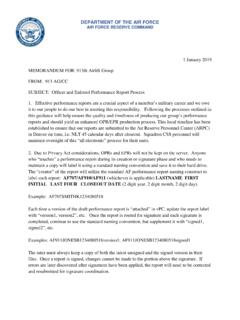Transcription of Small Unmanned Aircraft System Aircrew Training Program ...
1 TC Small Unmanned Aircraft System Aircrew Training Program August 2013 DISTRIBUTION RESTRICTION. Approved for public release; distribution is unlimited. Headquarters Department of the Army This publication is available at Army Knowledge Online ( ). To receive publishing updates, please subscribe at *TC (TC 1-611) Distribution Restriction: Approved for public release; distribution is unlimited. *This publication supersedes TC 1-611, dated 2 August 2006. i Training Circular No. (1-611) Headquarters Department of the Army Washington, DC, 19 August 2013 Small Unmanned Aircraft System Aircrew Training Program Contents Page v Chapter 1 INTRODUCTION.
2 1-1 Responsibilities .. 1-1 Chapter 2 Aircrew Training Program .. 2-1 Overview .. 2-1 Standardization Program .. 2-2 Commander s Evaluation .. 2-2 Mission-Level Status Progression .. 2-3 Mission Preparation .. 2-3 Mission Qualified .. 2-3 Training Year .. 2-3 Failure to Meet Aircrew Training Program Requirements .. 2-4 Removal from Mission Qualified Status .. 2-4 Currency .. 2-5 Chapter 3 EVALUATION .. 3-1 Evaluation Principles .. 3-1 Semi-Annual Proficiency and Readiness Test .. 3-1 No-Notice Evaluation .. 3-2 Proficiency Flight Evaluation.
3 3-2 Grading Considerations .. 3-2 Conducting Evaluations .. 3-2 Local Area Orientation .. 3-5 Chapter 4 UNIT TASK DEVELOPMENT .. 4-1 Aircrew Training Manual Task Model Development .. 4-1 Task Format .. 4-1 Chapter 5 UNIT Training .. 5-1 Training Program Requirements .. 5-1 Training Prerequisites .. 5-1 Task Considerations .. 5-1 Contents ii TC 19 August 2013 Training Strategy .. 5-2 Chapter 6 INDIVIDUAL OPERATOR Training RECORD .. 6-1 Individual Operator Training Record Requirements .. 6-1 Department of the Army Form 7122-R.
4 6-1 Department of the Army Form 4507-R .. 6-6 Department of the Army Form 4507-1-R .. 6-8 Department of the Army Form 4507-2-R .. 6-10 Chapter 7 COMPOSITE RISK MANAGEMENT .. 7-1 General .. 7-1 Composite Risk Management Concept .. 7-1 Responsibilities .. 7-2 Leaders .. 7-2 Safety Officer .. 7-4 Crews .. 7-4 Individuals .. 7-4 Composite Risk Management Training .. 7-4 Composite Risk Management Process .. 7-4 Risk Assessment Tools .. 7-6 Appendix A Small Unmanned Aircraft System TASKS .. A-1 GLOSSARY.
5 Glossary-1 REFERENCES .. References-1 INDEX .. Index-1 Figures Figure 4-1. Example of task format .. 4-2 Figure 4-2. Warning, caution, and note examples .. 4-3 Figure 4-3. Individual task condition statements examples .. 4-4 Figure 4-4. Condition statement issues .. 4-5 Figure 4-5. Special condition statement example .. 4-5 Figure 6-1. Sample DA Form 7122-R, page 1 .. 6-4 Figure 6-2. Sample DA Form 7122-R, page 2.
6 6-5 Figure 6-3. Sample DA Form 4507-R, page 1 .. 6-7 Figure 6-4. Sample DA Form 4507-R, page 2 .. 6-8 Figure 6-5. Sample DA Form 4507-1-R .. 6-9 Figure 6-6. Sample DA Form 4507-2-R .. 6-11 Figure 7-1. Composite risk management steps .. 7-5 Figure 7-2. Probability chart .. 7-7 Figure 7-3. Risk assessment matrix .. 7-7 Contents 19 August 2013 TC iii Tables Table 4-1. Task performance criteria .. 4-6 Table A-1. Small Unmanned Aircraft System task list .. A-1 iv TC 19 August 2013 Preface Training circular (TC) standardizes Aircrew Training programs (ATPs) and flight evaluation procedures.
7 This Aircrew Training manual (ATM) provides specific guidelines for executing Small Unmanned Aircraft System (SUAS) Aircrew Training . It is based on Training principles outlined in Army Doctrine Publication (ADP) & Army Doctrine and Reference Publications (ADRP) 7-0 ( Training Units and Developing Leaders) at the Army Training Network at: under the Unit Training tab. This ATM establishes crewmember qualification, refresher, mission, and continuation Training and evaluation requirements.
8 This manual applies to all SUAS crewmembers and their commanders in the Active Army, the Army National Guard Bureau (NGB), the United States ( ) Army National Guard (ARNG), the Army Reserve (USAR), and Department of the Army Civilians (DACs) unless otherwise stated, and any Unmanned Aircraft System (UAS) crewmembers and their commanders not covered by another ATM. This manual is not a stand-alone document; all the requirements contained in Army regulations (ARs) 600-105 (Aviation Service of Rated Army Officers), and AR 600-106 (Flying Status for Non-rated Army Aviation Personnel), and TC ( Small Unmanned Aircraft System Aircrew Training Program ) must be met.
9 The operator s manual is the governing authority for operation of the Aircraft . If differences exist between the maneuver descriptions in the operators manual and this manual, then this manual is the governing authority for Training and flight evaluation purposes only. Implementation of this manual conforms to AR 95-1 (Flight Regulations) and TC If a conflict exists between this manual, and TC , the ATP commander determines the method of accomplishment based upon the requirement and the unit s mission as to which manual takes precedence.
10 This manual in conjunction with ARs will help SUAS commanders at all levels; develop a comprehensive ATP. By using this ATM, commanders ensure that individual crewmembers and crew proficiency commensurate with units' mission and that Unmanned Aircraft crewmembers (UACs) routinely employ standard techniques and procedures. UACs will use this manual as a "how to" source for performing crewmember duties. It provides performance standards and evaluation guidelines so that crewmembers know the level of performance expected.















